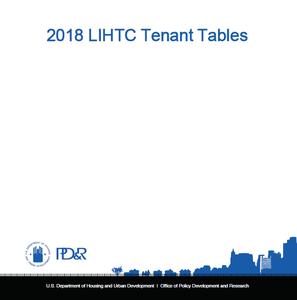
Nevada LIHTC tenants compared to US: older, higher income and less rental assistance.
Demographic information is collected each year on LIHTC tenants and compiled by HUD. The 2018 report, the most recent available, included information on 16,144 Nevada LIHTC units. That's about 58% of all the Nevada LIHTC units, according to the report.* Of the reporting units, information on tenant characteristics was available for 11,573 units.
Information is collected on LIHTC tenants nationwide using compliance data. Properties most likely to be missing from the dataset are older post-15 year properties, because they may no longer be subject to annual income certifications and are no longer overseen by the Internal Revenue Service. In Nevada, compliance auditors request post-15 properties fill out an alternate certification form. In some states, small properties may not be included because they may still submit income certifications by paper, and in addition, some properties with 100% rent restricted units may not be subject to annual income certifications. All types of properties are asked to submit either income certification forms or alternate forms in Nevada.
Nevada reported the highest proportion of senior households of any state with 53% of households (6,117) reporting at least one member 62 years old or older. Nationwide, about 36% of reporting LIHTC households had at least one member 62 years old or older. Nevada had a correspondingly low percentage of units with children under 18 (24%). Nationwide, 35% of reporting LIHTC households had children under 18.
The data shows that reporting Nevada tax credit properties are housing many families from even the poorest income groups. Median annual income for Nevada LIHTC households included in the report was $18,152, lower than last year’s report using 2017 data. However, this was higher than the U.S. median income for LIHTC tenants ($17,522). Few of Nevada's LIHTC units are targeted to be affordable to tenants with less than 30% of HUD family area median income (AMI) without assistance from either project based rental assistance or tenant based vouchers. Despite this, 40% of households in Nevada's LIHTC reporting units (4,499) were in this lowest income category. For the United States as a whole, an even greater proportion of LIHTC households, nearly 60%, were extremely low-income renters.
An additional 41% of Nevada LIHTC tenant households were in the income group between 30% AMI and 50% AMI. Twelve percent of the LIHTC tenant households were in the income category from 50% to 60% of AMI. Seven percent of Nevada LIHTC tenant households had an income greater than 60% of AMI.
However, 41% of the LIHTC households included in the report experienced moderate rent burden and an additional 19% experienced severe rent burden. Rent burden occurs when a household pays more than 30% of its income for rent and utilities and severe rent burden occurs when a household pays more than 50% of its income for rent and utilities. This means that about 60% of the Nevada households living in LIHTC properties experienced moderate to severe rent burden. For the United States as a whole, only 42% of LIHTC tenants experienced rent burden. Both numbers were higher than last year.
It is likely that a part of the difference in the levels of rent burden for the nation and Nevada is due to the larger proportion of LIHTC renters nationwide that receive rental assistance, either project-based or tenant-based. Thirty percent of the Nevada LIHTC households reported (3,474) that they had received some sort of rental assistance, whether project or tenant based. This compared to 41% of LIHTC households with rental assistance for the United States as a whole.
*The report total did not match Nevada Housing Division totals for 2018. However, according to NHD totals and the HUD report, 34% of units were not included in the report.
U.S. Department of Housing and Urban Development, Office of Policy Development and Research. February 2021. 2018 LIHTC Tenant Tables., https://www.huduser.gov/portal/Datasets/lihtc/LIHTC-TenantDataDocumentation-Tables.pdf










 Relay Service
Relay Service